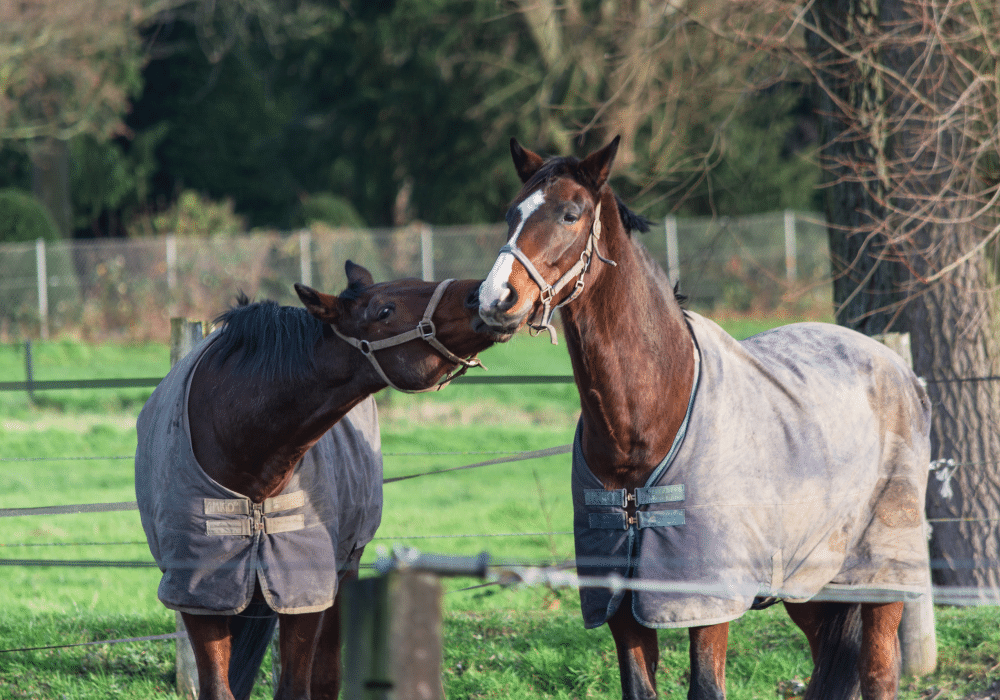As the days get shorter and colder, many horse owners will dig out their winter rug collection. However, not all horses require a rug all the time. In some cases, a slightly thinner rug (or no rug at all) could be better for the horse’s welfare.
This blog article investigates the topic of rugging and outlines some of the factors that should determine whether your horse needs a rug. It also covers why we rug horses, how horses keep themselves warm, and the dangers of over-rugging.
Why Do We Rug Horses?
To understand whether your horse requires a rug this winter, we must first understand why we rug horses in the first place. Horse owners usually rug their horses in the autumn and winter once they have been clipped. Clipping a horse removes all or part of its natural winter coat, which is designed to protect the horse against the elements during the winter. Therefore, we rug horses to help replace their lost winter coat.
Why Do We Clip Horses?
Horses are clipped in the autumn and winter for two main reasons. Firstly, horses remaining in work over winter may be clipped to help prevent them from overheating during exercise. Secondly, some horses are clipped to help them lose excess weight. In both cases, clipping is done in the interests of the welfare and comfort of the horse. You can find out more about clipping in our blog article: Why Do We Clip Horses.
How Horses Keep Themselves Warm
As well as a thick winter coat, horses have other ways of keeping warm. Firstly, the horse’s gut generates heat as it digests food. Furthermore, horses will naturally keep moving throughout the day as they graze, play, and move between feed and water stations. Horses will also seek shelter from the elements in the form of field shelters, trees, hedgerows and each other.
Aside from rugging, providing additional, good quality forage, suitable shelter and company will help your horse keep warm in the colder months.
To Rug Or Not To Rug?
Whether to rug, and which type of rug to use, depends on several factors. There is no one-size-fits-all solution, so you will need to consider your individual horse’s circumstances to determine whether they require a rug.
Do not rug your horse simply because you yourself are cold – horses’ bodies work differently to our own and they have a wider thermoneutral zone than we do. This means most healthy horses can regulate their own body temperature when the ambient temperature is between 5 and 25 degrees Celsius, with minimal energy expenditure.
Factors to consider when deciding whether to rug include:
- Whether the horse is clipped (and why – is the horse being clipped to help it lose weight?)
- The type of clip
- The age and type of horse
- The general health and condition of the horse
- The ambient temperature and weather
- Whether the horse is stabled or turned out
Clipping
When horses are clipped, we take away all or part of their winter coat. In many cases, this means we need to provide them with a rug to compensate when they are stabled and / or turned out. Some clips – such as a hunter clip – remove more of the coat than other clips, and this may mean the horse requires a thicker rug.
However, a good doer or a horse that has been clipped to help them lose excess weight may require a thinner rug or no rug at all. Furthermore, horses that have had a smaller clip may only require a thinner rug, or no rug at all if it is warm enough.
Age, Type and Health
Older, thinner horses are more likely to require a rug than younger, fatter horses. However, age does not always lead to weight loss and it is not uncommon for older horses (particularly those with PPID) to actually be overweight rather than underweight.
Some types (e.g. native breeds) are much better adapted to the colder weather than others (e.g. thoroughbreds). Native ponies will grow a very thick coat in winter, whereas thin-skinned breeds such as thoroughbreds and Arabs may find it more difficult to keep warm.
The type and amount of work your horse is doing will also influence whether they require a rug. Whilst regular exercise can help a horse keep warm, lean performance horses may lose muscle and condition in the colder weather.
Temperature and Weather Conditions
Cold days accompanied by wind and / or rain may require you to rug your horse differently. You may also need to change the type of rug used if the weather is changing frequently. Remember that whilst a thin rug or rain sheet may help keep the horse dry in light rain, the rug may become saturated in heavy or prolonged rain.
Turnout Routine
Horses that are used to being turned out, and have suitable shelter from the wind and rain, may not require a rug as much as a horse that is stabled most of the time. This is because a horse that is turned out will be moving around a lot more than a stabled horse, which will help it keep warm.
Potential Issues With Rugging
Rugging – and over-rugging – comes with its own set of risks, which horse owners should be aware of. Whilst this does not always mean you should not rug your horse, you may need to take additional steps to ensure they remain healthy and comfortable.
Rugs should always be well-fitting, clean, dry and secure. Accidents and injuries can occur if a rug comes loose or gets caught on something. Rugs that do not fit properly may rub and cause sores, skin problems and infections. Saturated rugs can result in the horse catching a chill and may lead to skin infections such as rain scald.
To keep your rugged horse healthy and comfortable, you should remove the rug at least daily and groom the horse thoroughly. This is important as they cannot benefit from mutual grooming and rolling because the rug is in the way. Removing the rug – even if it doesn’t require changing - will also allow you to check for any skin conditions, signs of rubbing or signs that the horse is getting too hot. You will also be able to check the rug for damage.
It is important to change the rug regularly – having a spare rug or two in the same weight will mean your horse will always have a clean, dry rug available whilst the other is being cleaned or repaired.
Finally, it is important to be aware of the dangers of over-rugging a horse. Horses find it easier to warm up than to cool down, and a horse that is overheating may become stressed as it tries to cool down. Hot horses will also sweat, which can lead to rubbing and skin problems if it is not allowed to evaporate.
Avonvale Equine Vets | Independent Equine Vet Practice
Avonvale Equine Vet Practice is an independent equine vet clinic based in Ratley, near Banbury. We are always happy to advise our clients on many areas of horse care, including rugging, weight management and feeding. Register your horse, pony, donkey or mule with us today.








